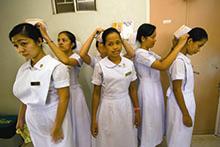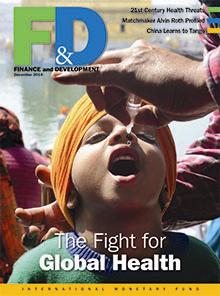
Typical street scene in Santa Ana, El Salvador. (Photo: iStock)
IMF Survey : Global Health Problems Span a Wide Spectrum
December 1, 2014
- Infectious and noncommunicable diseases threaten health
- Ebola fever epidemic points to need to improve health systems
- Health spending is moving from national to regional and local governments
The December issue of the IMF’s Finance and Development magazine looks at the serious health issues the world faces today, including infectious diseases such as Ebola fever and noncommunicable diseases such as cancer and mental health disorders.

Student nurses in Manila, Philippines (photo: Karen Kasmauski/Corbis)
ECONOMICS OF HEALTH
But any look at global health must include more than diseases.
The latest issue of F&D magazine examines a panoply of global health concerns—among them the growing importance of regional and local governments in health care delivery, the need for more efficient delivery of health services and for better functioning health systems, and the increasing number of organizations involved in the provision or health services—an area once almost solely the province of the World Health Organization (WHO).
Progress and threats
Harvard economist and demographer David E. Bloom, in a broad look at the status of human health, notes that although the world confronts many problems it has made great progress in the control and treatment of infectious diseases—the result of better medicine and vaccination, clean water and sanitation, and improvements in nutrition, education, and income. One of the clearest demonstrations of the advance in health is the sharp increase in life expectancy—which has increased by 23 years over the past six decades and is forecast to increase another 7 years by mid-century.
Gains in life expectancy are a hopeful indicator of what is possible in facing both longstanding and new health threats, Bloom writes. These threats include infectious diseases like Ebola, malaria, tuberculosis, HIV, hepatitis, diarrhea, and dengue (including drug-resistant forms of these and other pathogens), as well as chronic infirmities such as cardiovascular disease, cancer, respiratory disease, diabetes, neuro-psychiatric conditions, sense organ disorders, and musculoskeletal disorders.
In many respects, the most jarring feature of the global health scene is the massive disparity between its achievements and failings, he writes. For example, there is a 38-year gap between the country with the longest life expectancy, Japan at 83 years, and that with the lowest, Sierra Leone at 45. And 14 countries have a life expectancy at birth of less than 55 years, while 25 have one greater than 80 years.
Lessons from Ebola
Health was a major focus of the Millennium Development Goals established by the United Nations 15 years ago and will surely remain prominent on the development agenda, according to Bloom. But the nature, focus, and concrete indicators of any new goal (or goals) are not yet clear. Especially interesting, he says, will be the place of noncommunicable diseases; the emphasis on process, inputs, and risk factors rather than health outcomes; and whatever lessons the world community takes from the spread of diseases like Ebola and applies in defining a new set of aspirations for global health.
One lesson the world should learn from the Ebola outbreak is the need to prepare for worldwide epidemics, so-called pandemics, according to the World Bank’s Olga Jonas. Governments have chronically neglected human and veterinary public health systems to detect and control outbreaks of infectious diseases. It would cost about $3.4 billion a year to bring health systems in emerging and developing countries up to the standards needed to cope with infectious disease outbreaks—a minuscule percentage of what a pandemic would cost the global economy, not to mention the immeasurable pain and suffering that would occur.

Cover of December 2014 F&D magazine. Boy receiving polio vaccine in Amritsar, India (photo: Narinder Nanu/AFR/Getty Images)
Managing health
A major change in the economics of public health spending has been the devolution of outlays from central governments to regional and local governments, according to Amanda Glassman, of the Center for Global Development (CGD), and Victoria Fan of CGD and the University of Hawaii. Moving health functions and spending to the subnational level has resulted in many successful innovations in health care delivery, but has also caused many problems because regional and local governments often lack the administrative capacity and transparency to undertake these responsibilities.
It is not only at the national level, though, that things are murky. At the multinational level, so-called global health governance is splintering. The World Health Organization once had the stage to itself, according to Devi Sridhar of the University of Edinburgh and Chelsea Clinton of Columbia University. Today, though, public-private partnerships and private foundations are zeroing in on specific diseases or conditions—for example, AIDS and maternal health—while the World Bank is spending heavily on health issues.
The cost of health care remains a problem among both developed and developing economies. If governments are to be able to increase health services without having to reduce spending in other key areas such as education, they must find ways to make health spending more efficient. IMF economists David Coady, Maura Francese, and Baoping Shang outline potential areas where efficiency could be increased.
â– Also in the December 2014 issue of F&D, IMF and World Bank economists examine the recent slowdown in global trade; the IMF’s Maureen Burke profiles market matching expert and Nobelist Alvin E. Roth; and Back to Basics outlines the economic principles of taxation.


